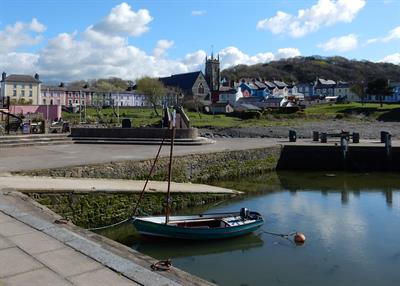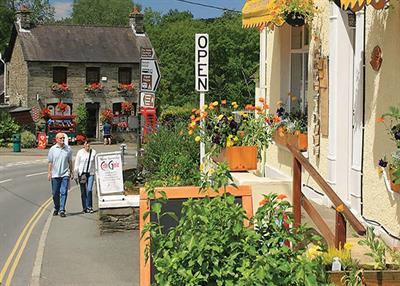


Towns and Villages
ABERAERON

Aberaeron is picture postcard pretty with its colourful Georgian style houses and graceful architecture. Built in the early 1800s, Aberaeron is one of Wales's first ‘planned’ towns, and the brainchild of the Rev Alban Jones-Gwynne.
Aberaeron is a popular centre for yachting and a great place to explore the wildlife of Ceredigion's Maritime Heritage Coast - the first offshore conservation area of its kind in the United Kingdom.
The closest town to the centre, Aberaeron is just 4 miles away and as such is the most convenient place to visit, eat out and shop.
With a petrol station, shops & convenience stores and a variety of restaurants & take-aways Aberaeron should provide most things that you may require during your stay..
ABERYSTWYTH

Aberystwyth is a lively university town, Victorian seaside resort complete with promenade and pier, a lovely place to visit to explore the Wales Coast Path along Cardigan Bay.
Aberystwyth has an annual programme of international and community cultural and sporting events.
Enjoy the natural spectacles of Aberystwyth's stunning sunsets, dramatic seascapes and famous winter starling murmurations.
Spot people 'kicking the bar’ - a quirky tradition exercised at the end of the Promenade at the foot of Constitution Hill.
Aberystwyth University was established in 1872 in a seafront building now known affectionately as the 'Old College'.
CARDIGAN

Cardigan (in Welsh: Aberteifi-mouth of the Teifi) is a historic market town with a castle at a strategic point on the river Teifi.
Cardigan has a vibrant contemporary arts and crafts scene, a lively shopping centre with independent shops, galleries and markets, and a spectacular coast nearby to explore.
Henry VIII granted Cardigan its charter in 1543 and by the 18th century Cardigan was the most important seaport in southern Wales.
It had a thriving herring and shipbuilding industry and its merchant fleet carried fish, slate, bricks, bark for tanning, corn and ale.
Cardigan was also a major embarkation point for emigrants to the New World.
CENARTH

Cenarth village lies on both sides of the Teifi River, the county boundary between Ceredigion and Carmarathenshire.
Cenarth Falls lie upstream from the river bridge, which has circular holes built into it to enable water to flow through it.
Near the village, at Cenarth Falls, the river Teifi emerges suddenly from a deep ravine over a ledge forming a maginificent waterfall when the river is in full spate and the pitcuresque spot is popular with tourists.
Below the bridge you can see fishermen, sometimes in coracles, pitching their skills against salmon and sewin. The National Coracle Centre with examples from around the world including Tibet and Iraq.
Near the bridge there is a holy well, dedicated to 7th century St Ludoc, and there is a standing stone in the church yard of nearby St Llawddog.
LAMPETER

Lampeter,a busy market town in the Teifi Valley on routes to the Cambrian Mountains and the Cardigan Bay coast, has an interesting history as an university town and centre of commerce.
Lampeter is a busy local commercial centre, providing services for a wide area, with a number of independent shops specialising in home furnishings, books, records, art and craft, clothing, food and drink.
There's a regular farmer's market as well as excellent cafes serving home made cakes, italian ice cream and other freshly prepared and artisan food.
Lampeter has a lively Transition Town community, and even has its own shopping loyalty card.
You'll also find supermarkets, a leisure centre and swimming pool, a local museum and a great network of walks to enjoy.
LLANDYSUL

The quaint town on Llandysul is located on the river Teifi on the border between Ceredigion and Carmarthenshire. The river Teifi at Llandysul is a mecca for anglers and canoeists.
Llandysul's oldest building is the 13th century Church of St Tysul. Inside the church is an ancient early Christian inscribed stone, called the Velfor Stone it commemorates Velvoria, daughter of Brohomaglus and inscribed in Latin and Ogham, an ancient Irish language - evidence of Irish settlers here at the time.
Historically, Llandysul was the hub of the Welsh woollen industry where thousands of people were employed in the water driven mills during the industrial revolution - weavers, spinners, dyers, knitters, drapers, tailors.
A few working mills still exist - such as Rock Mill at nearby Capel-Dewi. The National Wool Museum at nearby Drefach Felindre features working looms and weaving machines and lots of events and activities throughout the year.
NEWCASTLE EMLYN

Newcastle Emlyn is a town straddling the border of the counties of Ceredigion and Carmarthenshire in west Wales (though officially it is in Carmarthenshire) and lying on the River Teifi.
Newcastle Emlyn and Adpar are two adjacent communities in the Teifi Valley West Wales sitting either side of the River Teifi.
To the North is Adpar in the County of Ceredigion, to the South, Newcastle Emlyn in the County of Carmarthenshire.
Newcastle Emlyn and Adpar form a bustling market town community which grew up around a crossing point over the River Teifi, its swooping meanders made the site a natural defensive position first built on by the Normans.
Today, although the castle is in ruins, the town is lively and attractive and its people welcoming.
PONTRHYDFENDIGAID

At the heart of Pontrhydfendigaid - 'the bridge of the blessed ford' (known locally as ‘Bont’) is a narrow hump backed bridge across the river Teifi, whose source is about 5 miles away in the hills, at Teifi Pools.
The village is close to the 12th century monastery ruins of Strata Florida, once one of Europe’s most significant Cistercian monasteries and where archaeological digs are now revealing a much bigger site than originally imagined.
It is reputedly the burial site of Dafydd ap Gwilym, one of the great medieval Welsh poets.
Caradog Jones, the first Welshman to reach the summit of Mount Everest hails from Pontrhydfendigaid.
TREGARON

An historic market town, Tregaron is today a centre for ‘Trotian’ - horse trotting and carriage racing. The annual summer event attracts competitors from all over the UK and Ireland. It is also the home of the Welsh Gold Centre selling Celtic inspired designs.
Tregaron was a strategic point for drovers taking animals from West Wales to markets in England. Before railways, cattle were brought to Tregaron from many points in West Wales and then driven overland on the drovers roads through the Cambrian Mountains to markets in Hereford, London and even as far as Kent.The stunning Tregaron - Abergwesyn mountain road was originally the first stage of the drover's route.
It is said that around 30,000 cattle per year went through Tregaron and such was the trading importance of the town that the ‘Black Sheep’ Aberystwyth and Tregaron Bank was opened in 1810 to issue its own bank notes.
The number of black sheep (y defaid du) engraved on the banknotes indicated the number of pounds (1, 2, 10 etc). Original bank notes can be seen at Ceredigion Museum